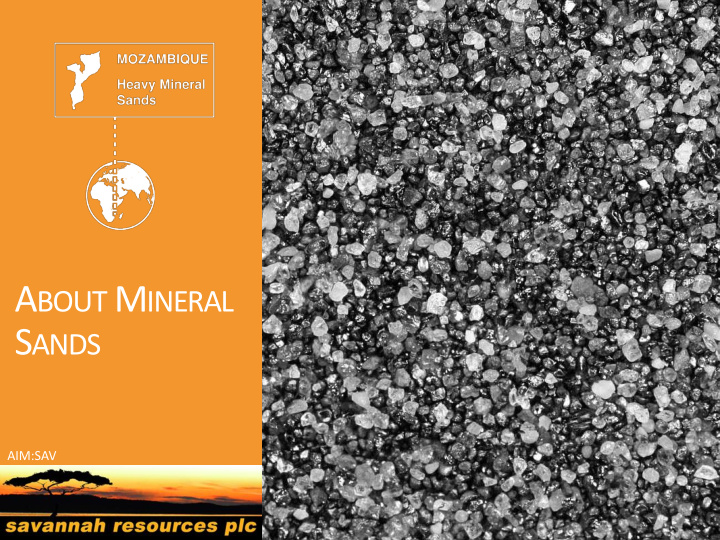



A BOUT M INERAL S ANDS AIM:SAV
2 What are Heavy Minerals? Most sand on the beach consists of grains of the mineral quartz (SiO2) • Mineral sands are old beach sands that contain concentrations of the important minerals, rutile, ilmenite, zircon and monazite. These minerals are heavy and are also called 'heavy minerals' Heavy minerals are those with an specific gravity (‘SG’) > 2.9 t/m3 • VHM : Valuable heavy minerals … those that are worth something! • Titanium is the 9th most abundant element • Forms of titanium are the minerals • Rutile ~ 94-96% TiO2 • Leucoxene ~ 65->90% TiO2 • Pseudorutile ~ 60-65% TiO2 • Altered Ilmenite ~ T’ween ilmenite and pseudo-ilmenite • Ilmenite ~ 35-65% TiO2 • Anatase ~ >90% TiO2 • Zircon ~ ZrSiO4 •
3 Why are Heavy Minerals Important? Zircon Over 50% of the zircon supplied to industry is consumed in the production of ceramics, including tiles, sanitary ware and tableware where it is used in the glazes. Zircon is also used in a range of other applications including zirconium chemicals, refractories, fused zirconia, catalytic fuel converters, foundry applications as well as water and air purification applications. Titanium Minerals The Titanium material is used in pigment production to make a pure white additive, which is light refractive, and used to produce materials such as plastics, paints and paper. Other applications for titanium products include TiO2 sponge for the production of Titanium metal, and welding rod applications.
4 How are Heavy Mineral Deposits Formed Rutile, ilmenite and zircon originally grew as crystals in igneous rocks such as granite, pegmatite and basalt and some metamorphic rocks.
5 How are Heavy Mineral Deposits Formed Over millions of years, these igneous and metamorphic rocks were weathered and eroded, and the grains of quarts and other minerals in the rock, including rutile, ilmenite, zircon and monazite, were washed down to the sea by heavy rainfall and fast flowing streams.
6 How are Heavy Mineral Deposits Formed The heavy minerals are then carried back up onto the beach by waves. As the waves washed up and down on the beach, they carried the lighter quartz grains with them back into the sea, leaving the grains of the heavy minerals rutile, ilmenite, zircon and monazite behind on the beach. Wind also helped to concentrate the heavy minerals by blowing away the lighter quartz sand.
7 How are Heavy Mineral Deposits Formed These processes were repeated many times over millions of years, eventually creating a large deposit of mineral sands on the beach.
8 How are Heavy Mineral Deposits Formed As the sea level rose and fell over geological time, the shoreline moved further inland and then back again. As this happened, the deposits of mineral sand were covered by more sand and built up or eroded and redeposited elsewhere.
Exploration Techniques: Target Generation The start of the process comes from the generation of ideas, which are based on the geology of a region, company exploration models, geophysics and the broad scoping of potential resources that might suit a current commodity market 9
Exploration Techniques: Reconnaissance 10 Exploration Low impact exploration, or ‘early’ exploration as it is often referred to, generally results in minimal ground disturbance with limited rehabilitation requirements
11 Exploration Techniques: Drilling The location of the targets identified will depend mostly on the results of the low • impact exploration conducted and any land access requirements Advanced exploration, especially drilling, is concentrated within small areas of • <1km 2
12 Resource Definition All the information gained through the drilling program is then used to calculate • the volume, quality and shape of the mineral resource Three dimensional computer-generated models are produced to better define the • shape and volume of the resource, along with information on chemical assays and mineral concentrations This information will be used to determine the type of mine required in the studies • below
13 Mineral Sands Processing 4. Tails taken back to pit and rehabilitated 1. Mining 3. Processing plant Mining 5. Heavy mineral concentrate 2. Ore split into transported products to processing plant Processing Plant 6. Products transported to market for sale Heavy Mineral Concentrate www.resource-finance.com
14 Rehabilitation Rehabilitation during mining is progressive with the tailings material returned to the pit from where it was mined and the area is rehabilitated as the mining continues.
www.savannahresources.com For further information on Savannah’s corporate social responsibility programme, please email: community@savannahresources.com
Recommend
More recommend